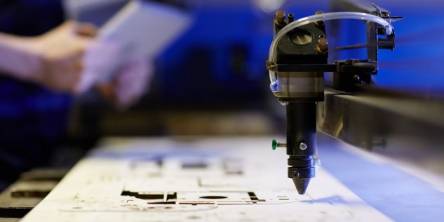Machining Process and Applications of Sapphire
Sapphire is a form of the material Alumina (Aluminium Oxide – Al2O3). It is often considered a precious gemstone. Sapphire is the single crystal form of alumina used in engineering ceramics. Its single crystal structure has no porosity or grain boundaries. Saphire products have a measured density which is close to the hypothetical value for pure Alumina material.
Sapphire gemstones are naturally occurring materials, frequently besides another form of pure alumina, ruby. However, they differ in color from each other. Synthetic sapphire has been available since 1902 after its discovery by the French chemist Auguste Verneuil. He heated alumina powder at high-temperature flame which resulted in subsequent deposits, in the form of a ‘lump’ of the material.
Detail about Machining Sapphire
The need of sapphire has drastically increased as all other materials have been exhausted. It also has unique properties. As a result, when sapphire is required, the difficulty occurred not in the selection of the material but rather in the ability to create the part in a configuration which is valuable and useful.
During the machining sapphire process, material is grounded to an appropriate size and tolerance and finely polished so that the material will be useful as planned. This process creates lots of difficulties in manufacturing challenge, it is always recommended to machine sapphire under experts’ supervision in order to succeed.
Properties of Sapphire:
Due to the hardness of 2,200 Hv, sapphire is wear and scratch resistant. It has various indicative physical and mechanical properties which lead to a wide range of industrial uses.
Industrial Applications of Sapphire
Electronic Substrate Applications: Sapphire is an attractive substance which can be produced in comparatively large dimensions. It is inert and can be machined at high temperatures. It is often used as a material for the epitaxial deposition of Gallium and Silicon Nitride.
- It can be used for insulating substrate applications in high-frequency, high-power CMOS integrated circuits. Often denoted as a Silicon on Insulator “SOI” or silicon on sapphire or "SOS" chip.
- As a substrates for the growth and deposition of Zinc Oxide nanowires and carbon nanotubes
In Display Devices: Sapphire can be used as a material for premium transparent watch face, however it has many other display type applications:
- FLIR (Forward Looking Infra Red) optics and sensor devices.
- Sapphire windows can be used in both short and long wavelength environments (Ultra Violet and Infra Red).
- Used in devices where corrosion resistance and high temperature is required.
- POS (point of sale windows) for bar code scanning.
Sapphire in Cutting Tools and Mechanical Components: Stiffness, high hardness and single crystal structure lead to use of sapphire material in many engineering or industrial components. Some examples are:
- Analytical equipment applications are common areas where the strength and transparency is vital. In many applications the resistance of sapphire to phosphoric or hydrofluoric acid is also significant.
- In aerospace applications, for windows manufacturing as sapphire has a high degree of impact erosion. Sapphire windows are mainly preferred choice due to the higher scratch resistance.
- Nozzles in water jet cutting and sandblasting.
Medical Applications of Sapphire
Due to the load bearing capabilities, fine microstructure, and light transmission qualities of sapphire present interesting options to the medical component designer:
- Systems using laser transmission and surgical tips.
- In endoscopic inspection tools, sapphire is often used as a window material.
- The fine microstructure of sapphire combined with polishing and skilled machining techniques produces cutter edges and ultra fine blade.
- Sapphire is also non- thrombogenic (does not causes blood clots).
- Biomedical implants used in dental applications.
- Used in making cosmetic laser surgical devices and powerful pulsed lights
- In making surgical mirrors and filters
- Sapphire lenses can be used in imaging applications, laser optics, and sapphire medical optics.
Similar Articles
When you see a steel ship in the harbor, the first impression is usually sheer scale.
Explore CNC turning—its components, process, benefits, applications, and future trends shaping modern precision manufacturing in various industries.
In the competitive industry of car manufacturing, attaining exceptional performance along with an innovative design needs the incorporation of modern manufacturing technologies
Facing delays, quality issues, or supply chain problems in hardware manufacturing? Learn the top 7 challenges—and practical fixes—to streamline production.
In the rapidly advancing landscape of high-tech manufacturing, electronics, and materials science, diamonds are no longer just gemstones they’re high-performance materials redefining what’s possible in technology.
A business in the manufacturing industry today has to ensure that it chooses the precision-engineered components suppliers keenly since the competition is very stiff
Selective Laser Sintering, or SLS, has established itself as one of the most reliable and widely used 3D printing technologies. This method is valued for its ability to produce complex, durable, and high-quality parts without the constraints of traditional manufacturing.
In the retail and display industry, the visual appeal of products is paramount. Customers are constantly drawn to displays that are not only eye-catching but also provide an immersive experience.
As previously established, CO2 laser technology operates by shining a high-power infrared beam on a mixture of gas that contains carbon dioxide, nitrogen, and helium. This technology is well known for the fact that it is able to engrave onto a variety of materials such as wood, glass, plastic, leather, and even some metals with high precision and without contact.









